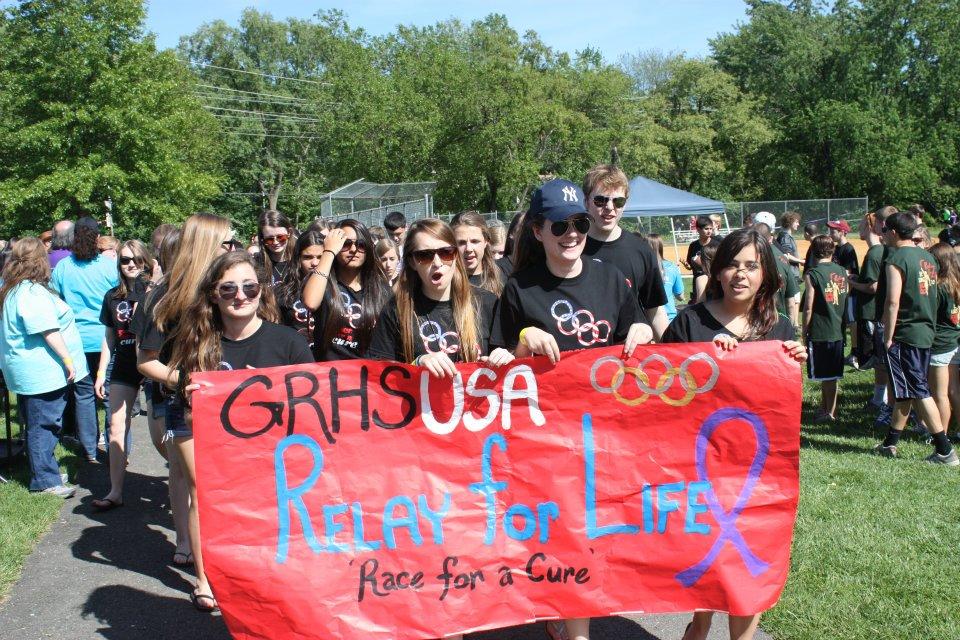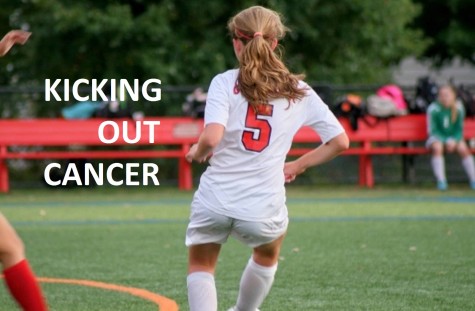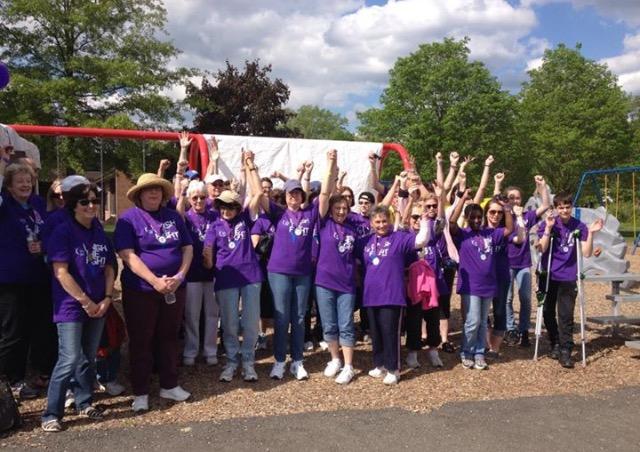Rock the relay
May 15, 2015
As daylight succumbs to darkness, the luminaria bags that outline the curves of the track illuminate the night sky.
Each bag represents a person. Someone’s mother, father, sister, brother, aunt, or uncle. A universal silence consumes the once very garrulous crowd of people as they come together to honor those who have battled, and continue to battle or have lost their battle with cancer.
The warm air is a mixture of late spring and early summer. A warm breeze travels through the crevices of the crowd, causing candle flames to flicker and bags to crinkle. Someone with a story to tell takes the stage and begins to talk, her voice sending chills throughout the field. This story touches someone affected by cancer and someone who has never had to endure the tribulations.
One individual starts with a candle, passing it to her neighbor and then his neighbor. A burst of light explodes and suddenly the vision of unity is apparent.
Cancer. This six-letter word can shatter a person’s life, but Relay for Life is a night when even the most devastating experiences can fuel the hope for finding a cure. Relay for Life is a night when hundreds of people from a small community gather and commit to living in a world with more birthdays.
Relay for Life began in Tacoma, Washington, a mid-sized urban port city. In the mid 1980s, Dr. Gordy Klatt, a colorectal surgeon, combined his passion for the American Cancer Society and his interest in running marathons to raise money for research. His evening of raising money became known as the City of Destiny Classic 24-Hour Run Against Cancer. In 1986, 19 teams took part in the first team relay event on the track at the Stadium Bowl and raised $33,000.
Years later, Glen Rock continues the tradition of Relay for Life by coming together for a weekend in May to shed light on those affected within this small town.
“Glen Rock is inspirational because of the participation of students, council members, teachers, community residents… they come together for one another,” said Kaitlin Cheico, the community manager of Relay for Life of Glen Rock. “They honor their loved ones and actively are making a difference in the fight against cancer.”
Glen Rock High School junior Matthew Rella is one of the many participants who has been affected by cancer and takes advantage of all that Relay for Life has to offer.
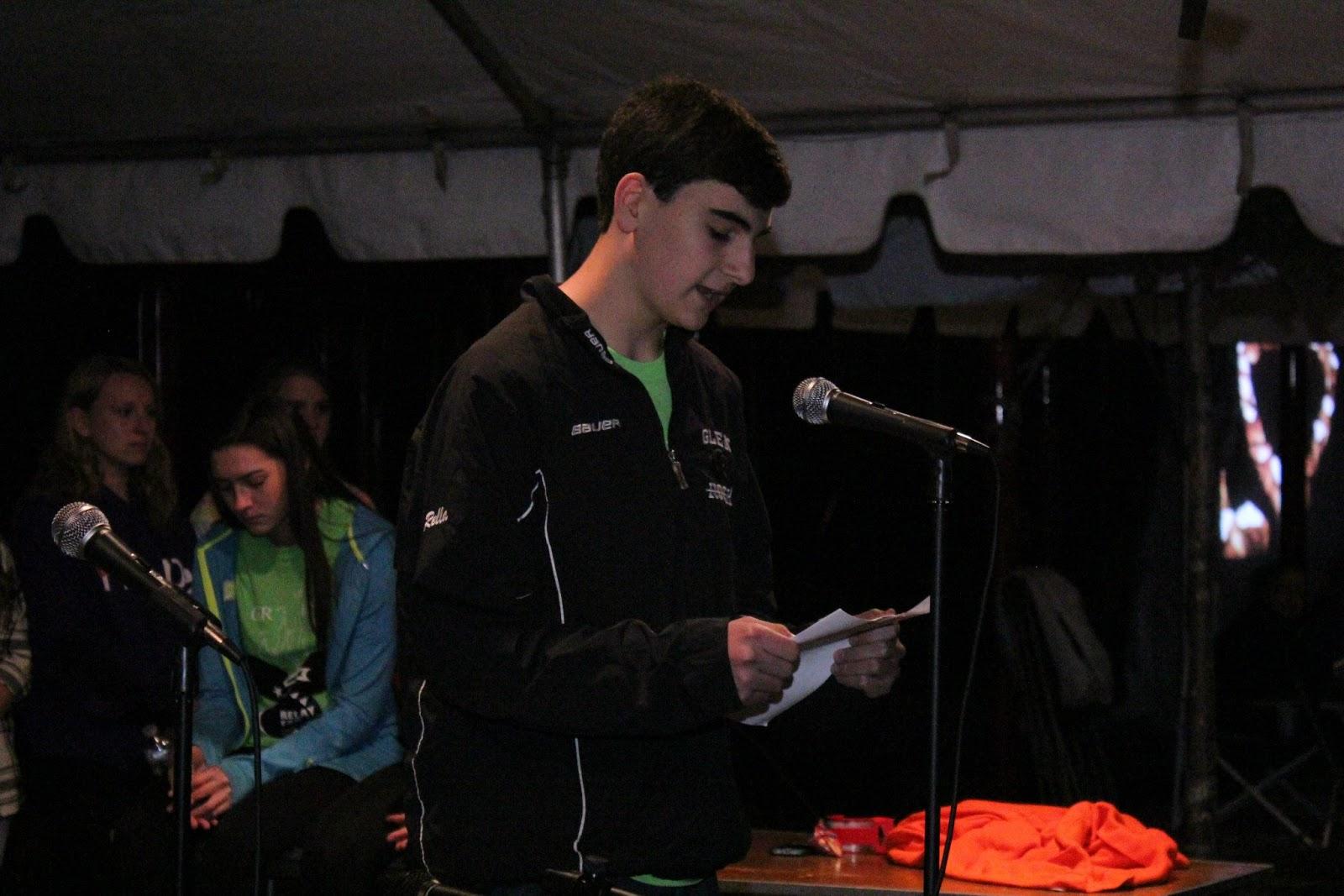
A painful loss
The early summer sun warmed the June air. Happy birthday wishes barraged the young Matthew Rella as he walked the halls of Alexander Hamilton Elementary School. As his classmates, preoccupied by hunger, made their way to the lunchroom, the boy heard a call on the loudspeaker. His dad was in the lobby waiting to pick him up, but he had no idea why he was leaving school.
The leather seats in the car burned from the long sheet of sunlight cutting through the windows as the pair drove home. The sky was a cloudless diamond, clear and shining. The rays of sunshine seemed to go on forever. No horizon. No depth. Only clear blue.
Whenever I picture her, there is just that one day that I always go back to. I don’t know why. It’s just the first images that pops up into my head.
— Matthew Rella
As they pulled into the driveway, a woman was waiting in doorway. She wore a black long sleeve shirt and black dress pants with a shawl wrapped around her shoulders.
“Matt, I hope you have a Yankees jersey and a hat,” she said, holding out two tickets to a Yankees game with an infectious smile on her face.
“My dad and I were just talking about how in her last few months how she was different and that’s not how we would remember her,” Matthew Rella said to me as we sat in the high school media center. “Whenever I picture her, there is just that one day that I always go back to. I don’t know why. It’s just the first images that pops up into my head.”
Joan Rella suffered from breast cancer, the same disease that affects thousands of other American women every year. In 2015, thus far, 231,840 new cases of invasive breast cancer have been found in women. That number is growing.
Yet despite the disease, she never lost her sense of hope.
“Her outlook, her look on things never changed. She was always so positive,” Rella said. “And then she started losing her hair, and she started physically changing.”
“She didn’t have as much energy. She’d have to be on the couch or the bed for a really long time and she was never as talkative, but she’d always be positive. When she could barely talk she’d still be like, ‘Oh I hope you’re excited I think we’re going to Florida this summer,’ or like, ‘It’s nice and warm there. We’re going to go to Universal.’ She was always so positive.”
A 1978 graduate of the Fashion Institute of Technology in New York, Rella’s mother found solace in fashion. She worked in the city and started her own company, Joan Rella Designs, LLC of Glen Rock, which specialized in personal interior design.
Not surprisingly, the sewing room in the Rella household was filled with character. Three sewing machines punctuated the room. Fabric was draped all over: cotton, silk, rayon, woven blends. Behind every corner, there was another roll. Deliveries would always find their way up to that room. An organized chaos, one might call it. She knew exactly where everything was but no one else could pin-point the location.
A familiar scene might depict Rella’s mom sitting focused, eyes trained on the project ahead of her. The needle bar is driven up and down, puncturing the fabric each time to create a new stitch. A glass of red wine rests next to the machine — red wine was always her favorite. In the background, Bruce Springsteen’s “Born to Run” is playing softly as sunlight seeps through the window, guiding her hands and machine as they move together in sync.
“She loved what she did; she was always working, but she always found time for everyone else. Do everything to clean the house and cook dinner,” Rella said. “I don’t know how she did it. Always made time.”
“We used to go to San Diego every summer to see my aunt and cousins,” Rella recalled. “My mom loved everything about San Diego. We were on a hiking trail and there was this giant rattlesnake and my mom got so scared. She was like, ‘Oh my God! We have to leave!’ And then I think like a guy scared it off and she like freaked out. We went back to my aunt’s house and she was like hysterical. She was like screaming and stuff and my dad and I were laughing and we were like, ‘Oh it’s just a snake!’”
Besides her dedication to her work and family, Rella’s mom also showed dedication towards Relay for Life.
She would show up fashionably early before the mass crowds arrived, mingling with old and new faces. She beamed with pride as she introduced her children to everyone who crossed her path. As the afternoon sky transformed to dusk, the bright orange patches stand out against the grey clouds. The silhouettes of the trees are outlined in the sky as the light percolates through the branches.
The overnight experience of Relay is meant to parallel the physical and mental effects of cancer. The setting sun symbolizes the climactic moment when a patient is diagnosed with cancer. As the hours dwindle on, relayers begin to feel tired, which correlates with a patient experiencing the impeding tribulations of treatment. Once the sunlight breaks through the night sky at dawn, it symbolizes the near end of treatment and when the morning sun is effulgent, the end of treatment has arrived and life goes on.
The first year after my mom died. It was probably two months or so after she died in sixth grade. That one was definitely the worst and the toughest emotionally.
— Matthew Rella
“It was always a difficult day for her because of the ceremony, but I think she was also happy and fortunate to be a part of it and happy to see everyone and how effective it was,” Rella explained.
Although Relay for Life is there to instill hope in individuals and to honor the joyous times, sometimes it can be emotionally draining.
“The first year after my mom died. It was probably two months or so after she died in sixth grade. That one was definitely the worst and the toughest emotionally,” Rella said. “I remember crying more than I’ve ever cried.”
As Rella stood in the midst of the luminary ceremony, his dad came over and embraced him saying, “We’ll get through this.” People that Matt had never met before came up with tears streaming down their faces offered their condolences and asked if they too could give him a hug.
The universal support exhibited at Relay for Life is what makes it so special for families such as the Rella family. It is the night where unity can overcome cancer.
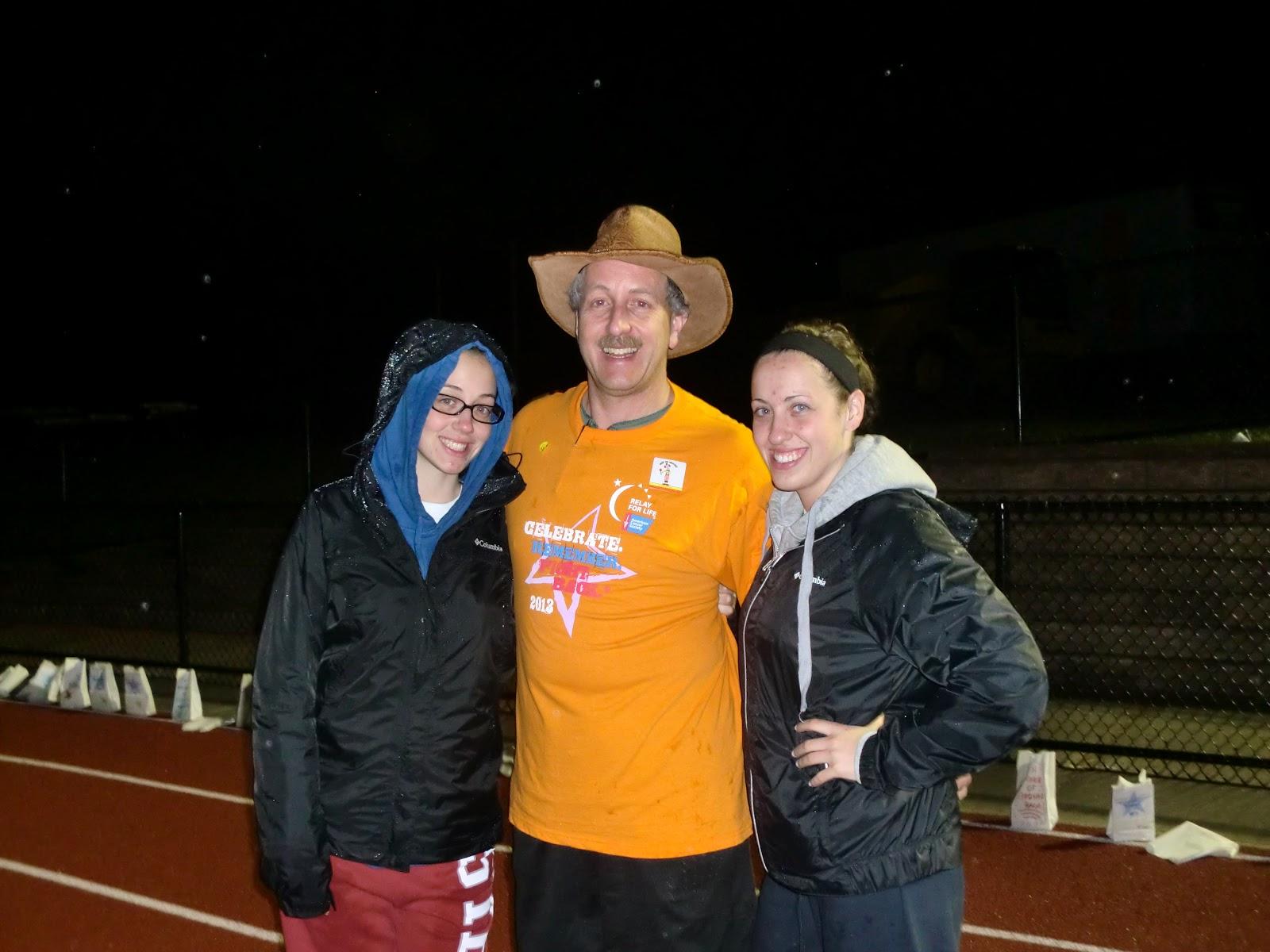
Photo Credit: Ronald Panicucci
Ron Panicucci with two of his three daughters, Melissa and Michele
Banding together
“Relay for Life is an opportunity for those who have been touched by cancer to share their experiences,” said Ronald Panicucci, the chairman of Relay for Life of Glen Rock. “It promotes awareness to the community and at the same time provides a huge showing of support to those currently battling the disease.”
Glen Rock has always had a positive outcome of participants at Relay for Life. So what is it about this small town gathering that intrigues everyone?
“I think Glen Rock kids always see doing some kind of civic duty is the right thing and I think also a lot of kids have a kind of personal story, which is sad, linking them to cancer,” said Kathleen Walter, a history teacher at Glen Rock High School whose daughter, Jean, was diagnosed with a rare cancer when she was six years old. “I think Glen Rock has always been a great community and I think that’s one of the reasons why it’s so big.”
…they keep saying, ‘You can do better,’ and keep challenging us. And Glen Rock has always actually risen to that term.
— Kathleen Walter
Due to the overwhelming amount of participants and increasing popularity, the American Cancer Society heavily relies on Glen Rock’s consistent fundraising every year.
“They know how much they spend in research, how much they spend in the support services, so they know how much they have to raise every year and so they always look to us,” Walter said. “‘They’re good for $100,000,’ and they always put a lot of pressure on to make sure and then they keep raising our goal of how much we’re supposed to make every year. So I think that’s the change. That they keep saying, ‘You can do better,’ and keep challenging us. And Glen Rock has always actually risen to that term.”
As the years go by, more students and other local towns have become invested in Relay. Organizations from neighboring areas such as Ridgewood, Fair Lawn, Hawthorne and North Haledon attend, making it more than just a school event.
“During the past two years, we have been trying to extend our outreach to recruit teams from outside the school community, and we have been successful doing that,” Panicucci said. “My co-chair Donna Nihen worked tirelessly meeting with many local businesses and organizations in an effort to increase participation.”
Prior to this year, Glen Rock High School has always had one team. As an individual student, it can be easy to get lost during all the preparation and just show up on the day of. This year it has been decided that there will no longer be one high school team. Instead, students will make their own teams, which will increase the overall number of teams at relay. It will also make it easier for students to participate beforehand and play a bigger role.
“By having the small teams, it’s actually gotten more people involved in doing the work of the whole event. That’s the best part about it. It’s a bigger effort on more people’s parts, and I think it also brings them closer to the meaning of relay,” Walter said.
The greatest showing of participation and unity is at night, when people flood the field just in time for the Luminaria ceremony.
“It really hits home and it should for a lot of people,” Matthew Rella said. “I think just overall people having the ability to celebrate and look back on the life of a loved one that they’ve lost, and they’re really pushing for a day when they don’t have to lose anyone.
“It’s a lot of work and I don’t know how they do it every year, but they do and they do such a good job.”
In American culture, music plays a significant role in unifying people and bringing joy to listeners. Relay for Life is no exception to this ideology.
“Music has always been a great way to bring people together, to celebrate, to heal, to inspire and send a message that we are here to fight back until we have ultimately found the cure,” said Ryan Pifer, the artistic director at Porch Light Productions in Glen Rock. Pifer puts together the entertainment and performances throughout relay.
“The music helps keep the energy up as Relayers walk and run the track, and their extra donations provide the necessary funds to help put an end to this horrific disease that has taken far too many,” he said.
How the money helps
As of 2014, there were 318.9 million people living in the United States. A single dollar bill has most likely encountered a decent amount of these individuals in its travels. About 40.4 percent of these Americans will be diagnosed with cancer at some point in his or her lifetime and a single dollar bill can help make a difference. If a person were to track a dollar bill that was part of a relay donation, where would it go?
72 percent of all resources go towards research, patient support, prevention information, education, detection and treatment. The remaining 28 percent is divided between management, infrastructure and fundraising costs.
As the donations begin their very own journey, they find their way to the Hope Lodge, one of the most important facilities that the ACS provides. The Hope Lodge is a place where cancer patients and their caregivers can stay for free while they undergo treatment away from home. Without the worry of housing costs, the patient can focus all of his or her attention towards treatment.
The journey continues to benefit the ACS CHANGE grants. These provide thousands of screenings to people in underprivileged communities. No matter the financial situation, Relay for Life says that every individual should be inclined to health screenings, so the ACS is there to fill the gaps.
“Our family was definitely helped when my mother-in-law ended up with liver cancer. She ended up with hospice care because her liver failed and eventually knew that there was nothing they could do for her, and so the American Cancer Society provided some of those services,” Walter said about the services that the ACS provides. “They also helped my mother-in-law get a wig and be fit correctly for wig.”
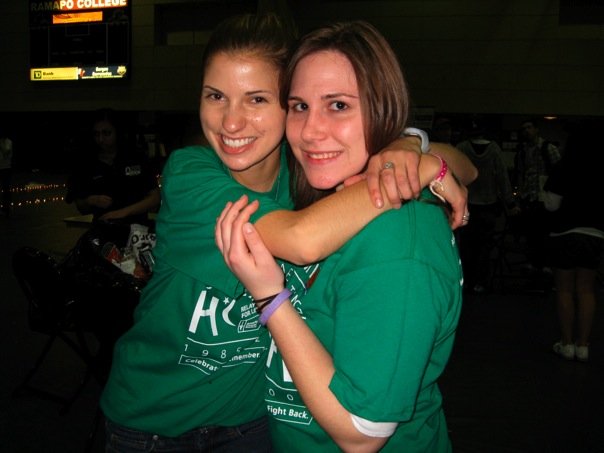
Kaitlin Cheico (right) and her friend Kait O’Donohue (left) at their college Relay for Life
$160 million is spent on cancer research and health professional training. $304 million is spent on patient support. $153 million is spent on education and prevention. $97 million is spent on detection and treatment.
“Through Relay For Life and the work the American Cancer Society is doing I have hope that we will have more cancer survivors,” Cheico said. “Those who I know that are still going through their cancer journey are an inspiration to me.”
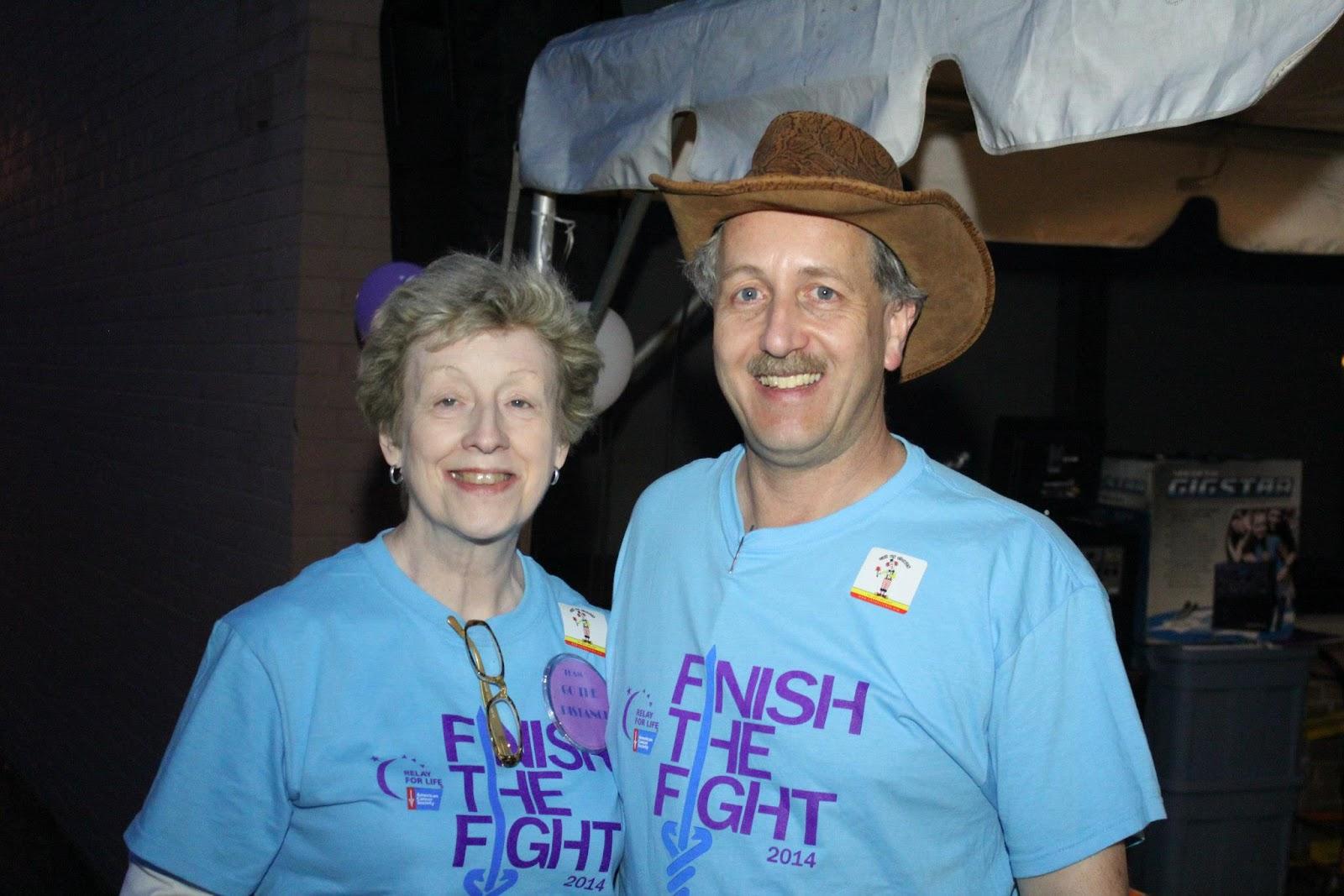
Cherished moments
“It definitely changed my look on things: how short life can be and how easily something can be taken away and what you take for granted,” Rella said to me as we sat back in the library.
It was 5 o’clock on a Monday morning. The sun was barely beginning to break through the night time barrier. Rella, who was still sleeping, was awoken by his dad in an alarming manner.
“Matt, wake up, wake up,” he said as Matt groggily opened his eyes. “Mom’s gone. God took her.”
Everything seemed surreal, as if the world were no longer in a constant motion. Matt walked downstairs to a living room filled with his entire family. A sense of unity penetrated the room, despite the tears and sorrow.
“It didn’t really hit me right away. I had realized what had happened but it felt like it wasn’t real,” Rella said.
The Rella family is not the only family who has been affected by cancer in the small town of Glen Rock. Their loss has empowered them to continue fighting for a cure, which is what relay is truly about.
The present truly is a present.
— Robert Panicucci
Relay for Life emphasizes cherishing moments with loved ones and honoring those who fought their battles with cancer. For the Rella family, it’s honoring the woman who put everyone before her. The woman who loved fashion and portrayed her creativity for all to see. The woman who loved San Diego and the sound of the waves greeting the shore on the beach.
“It’s a disease that’s all around us and affects many aspects of our life including home, work, school and social. The most important feeling that came along with all these losses is that life is short, and we need to value every moment we are given,” Panicucci said. “The present truly is a present. As a result, I never put off doings something I want to do to the future. I do it and live the lyrics of One Republic’s I’ve Lived.”
The Sunday morning after relay arrives. Students and participants are scattered all over the field. Although their bodies feel run down, the internal feeling of accomplishment warms their bodies. As the closing ceremony begins, the sun rises, just as a triumphal cancer patients rises from his or her last round of treatment.
“If you’ve never been a part of Relay For Life please come down and join us for a few minutes, a few hours on May 16 at Alexander Hamilton Field,” Cheico said. “I promise that it will change your life to see our opening lap packed with cancer survivors and you will be filled with hope by the amount of community members present.”
Relay for Life will take place this Saturday, May 16.
